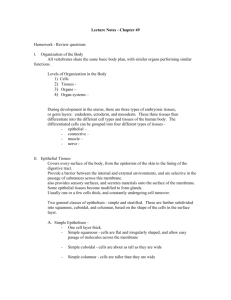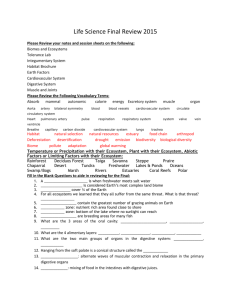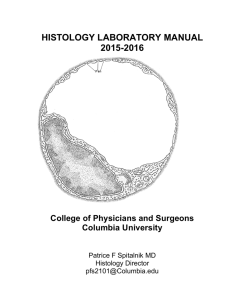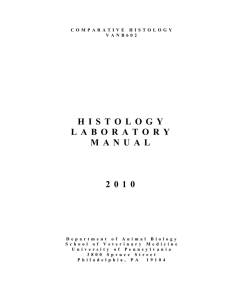ANIMAL CELLS AND TISSUES
advertisement
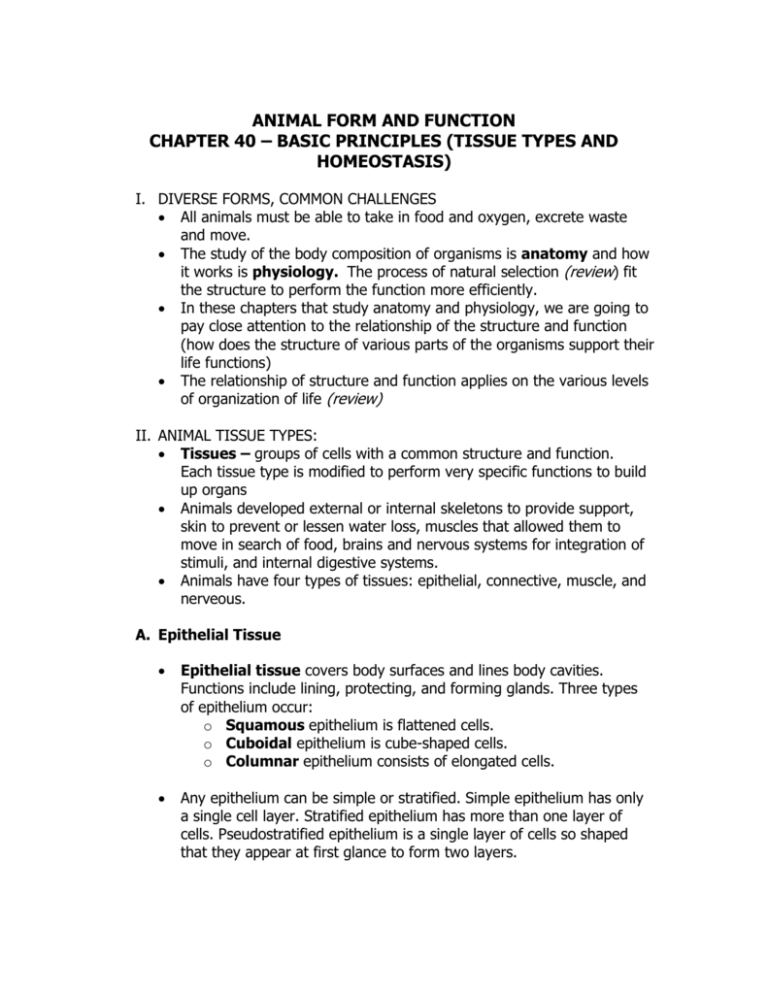
ANIMAL FORM AND FUNCTION CHAPTER 40 – BASIC PRINCIPLES (TISSUE TYPES AND HOMEOSTASIS) I. DIVERSE FORMS, COMMON CHALLENGES All animals must be able to take in food and oxygen, excrete waste and move. The study of the body composition of organisms is anatomy and how it works is physiology. The process of natural selection (review) fit the structure to perform the function more efficiently. In these chapters that study anatomy and physiology, we are going to pay close attention to the relationship of the structure and function (how does the structure of various parts of the organisms support their life functions) The relationship of structure and function applies on the various levels of organization of life (review) II. ANIMAL TISSUE TYPES: Tissues – groups of cells with a common structure and function. Each tissue type is modified to perform very specific functions to build up organs Animals developed external or internal skeletons to provide support, skin to prevent or lessen water loss, muscles that allowed them to move in search of food, brains and nervous systems for integration of stimuli, and internal digestive systems. Animals have four types of tissues: epithelial, connective, muscle, and nerveous. A. Epithelial Tissue Epithelial tissue covers body surfaces and lines body cavities. Functions include lining, protecting, and forming glands. Three types of epithelium occur: o Squamous epithelium is flattened cells. o Cuboidal epithelium is cube-shaped cells. o Columnar epithelium consists of elongated cells. Any epithelium can be simple or stratified. Simple epithelium has only a single cell layer. Stratified epithelium has more than one layer of cells. Pseudostratified epithelium is a single layer of cells so shaped that they appear at first glance to form two layers. Functions of epithelial cells include: o movement materials in, out, or around the body o protection of the internal environment against the external environment o secretion of a product Glands can be single epithelial cells, such as the goblet cells that line the intestine. Multicellular glands include the endocrine glands – these are glands that release hormones into the bloodstream. To release hormones they use exocytosis and do not have a separate duct formed for the release Exocrine glands are formed of ducts and secretory portions o ducts can be straight (simple glands) or branched (compound glands) o secretory portions B. Connective Tissue Connective cells are separated from one another by an extracellular matrix. The matrix may be solid (as in bone), soft (as in loose connective tissue), or liquid (as in blood). Two types of connective tissue are Loose Connective Tissue and Fibrous Connective Tissue. Connective tissue serves many purposes in the body: o binding o supporting o protecting o forming blood o storing fats o filling space Some connective tissues are cartilage, tendons, ligaments, bone and blood Adipose tissue has enlarged fibroblasts storing fats and reduced intracellular matrix. Adipose tissue facilitates energy storage and insulation. Bone has calcium salts in the matrix, giving it greater rigidity and strength. Bone also serves as a reservoir (or sink) for calcium. Protein fibers provide elasticity while minerals provide elasticity. Two types of bone occur. Dense bone has osteocytes (bone cells) located in lacunae. Lacunae are commonly referred to as Haversian canals. Spongy bone occurs at the ends of bones and has bony bars and plates separated by irregular spaces. The solid portions of spongy bone pick up stress. Blood is a connective tissue of cells separated by a liquid (plasma) matrix. Two types of cells occur. Red blood cells (erythrocytes) carry oxygen. White blood cells (leukocytes) function in the immune system. Plasma transports dissolved glucose, wastes, carbon dioxide and hormones, as well as regulating the water balance for the blood cells. Platelets are cell fragments that function in blood clotting. C. Muscle Tissue Muscle tissue facilitates movement of the animal by contraction of individual muscle cells (referred to as muscle fibers). Three types of muscle fibers occur in animals: o skeletal (striated) o smooth o cardiac Muscle tissue and organization is shown below: Muscle fibers are multinucleated, with the nuclei located just under the plasma membrane. Most of the cell is occupied by striated, thread-like myofibrils. Within each myofibril there are dense Z lines. A sarcomere (or muscle functional unit) extends from Z line to Z line. Each sarcomere has thick and thin filaments. The thick filaments are made of myosin and occupy the center of each sarcomere. Thin filaments are made of actin and anchor to the Z line. Skeletal (striated) muscle fibers have alternating bands perpendicular to the long axis of the cell. These cells function in conjunction with the skeletal system for voluntary muscle movements. Smooth muscle fibers lack the banding, although actin and myosin still occur. These cells function in involuntary movements and/or autonomic responses (such as breathing, secretion, ejaculation, birth, and certain reflexes). Smooth muscle fibers are spindle shaped cells that form masses. These fibers are components of structures in the digestive system, reproductive tract, and blood vessels. Cardiac muscle fibers are a type of striated muscle found only in the heart. The cell has a bifurcated (or forked) shape, usually with the nucleus near the center of the cell. The cells are usually connected to each other by intercalated disks. D. Nervous Tissue Nervous tissue, functions in the integration of stimulus and control of response to that stimulus. Nerve cells are called neurons. Each neuron has a cell body, an axon, and many dendrites. Nervous tissue is composed of two main cell types: neurons and glial cells. Neurons transmit nerve messages. Glial cells are in direct contact with neurons and often surround them. The neuron is the functional unit of the nervous system. Humans have about 100 billion neurons in their brain alone! III. Overview of Human Organ Systems A. Communication and Integration Systems: These organ systems detect external and internal stimuli and coordinate the body’s responses. The Nervous System – Consists of the brain, spinal cord, nerves and sensory organs. It detects internal sensory feedback and external stimuli, collects and interprets the incoming information and generates the appropriate response. The Sensory System – Basically, it is a subset of the nervous system that specializes to detect and forward information. The Endocrine System – It issues chemical signals, called hormones to regulate and fine-tune chemical processes in the body B. Systems of Support and Movement: Muscular System – The muscles form the flexible and moveable part of this system Skeletal System – forms the rigid part of this system that provides protection and support for the muscles to move on. C. Regulation and Maintenance of the body chemistry: Digestive System – Related to how and what we eat and how we absorb nutrients from food and get rid of wastes. Circulatory System – is related to distributing necessary nutrients all over the body and collect waste materials Respiratory System – is related to obtaining oxygen and expelling carbon dioxide out of the body Urinary (excretory) System – regulates the concentration of body fluids and salts (osmoregulation) and gets rid of nitrogenous waste D. Body Defense Systems: Integumentary System – the first line of defense against microorganisms is the skin Immune System – once disease causing agents get into the body this system will have various ways to fight them Lymphatic System – closely working with the immune system E. Reproduction: Reproductive System – responsible for producing gametes and all necessary materials for reproduction to reassure the continuity of life IV. Homeostasis The sophisticated machinery of cells, tissues, organs and organ systems can work only if the conditions inside the body remain within narrow limits. Homeostasis is the maintenance of a dynamic and stable internal environment. There are hundreds of conditions that are monitored by the body constantly. These conditions include temperature, pH, water concentration, salt concentration, oxygen and glucose concentration The ultimate control system is the nervous system in upkeep of stable internal conditions A. Negative Feedback Mechanism: A mechanism that maintains homeostasis: Specialized sensors (cells or membrane receptors) detect conditions inside or outside of the body. The sensors send messages to a control center (integrating center) and the control center compares the message (information) to a set normal point. If conditions deviate from a set point, biochemical reactions are initiated to change conditions back to the set point. Effectors receive the information from the control center to act against the disturbing condition and return it to normal (they generate a response). This process is called negative feedback because the response acts against the condition (if the temperature too high, the effectors will act to lower it etc.) B. Positive Feedback Mechanism: In a few cases the body uses positive feedback. The basic map of the process is the same as the negative feedback but the effectors act to accelerate or accumulate the condition not to moderate it. As a result, these systems are highly unstable and can be kept up only for a short period of time Examples: blood clotting, pepsin production and protein digestion in the stomach, child birth – uterine muscle contractions C. Regulating Body Temperature (Thermoregulation) Animations: http://bcs.whfreeman.com/thelifewire/content/chp41/41020.html http://www.bbc.co.uk/schools/gcsebitesize/teachers/biology/thermoreg ulation.shtml Refers to all the processes that are used by animals to maintain their body temperature Ectotherms – (most invertebrates, fish, amphibians and reptiles) generate relatively little metabolic heat but gain most of their heat from external sources. They generally need fewer calories but have no sufficient insulation. They usually use behavior to regulate their temperature: they orient their body toward the sun, use shivering to generate heat. They may also use contraction and dilation of blood vessels to control blood flow. Endotherms – (mammals and birds) are warm blooded animals that use mostly heat generated during their metabolism to heat themselves. They use various methods to keep their body temperature constant: o substantial calorie needs to support this system o have sufficient insulation o use contraction and dilation of blood vessels to control blood flow o use evaporative cooling in the form of sweating or panting Thermoregulation in mammals: o The major control center is the hypothalamus o When too hot – thermoreceptors in the skin, blood vessels detect the heat – stimulate the heat-losing center of the hypothalamus – cause dilation in the peripheral (skin) blood vessels, production of sweat stimulated (sweat glands), metabolism stimulating hormones are inhibited o When too cold – thermoreceptors activate the heat-promoting center of the hypothalamus – nerves constrict blood vessels in the periphery, inhibit sweating, metabolism stimulating hormones are generated o Fever – substances (pyrogens) cause the rise in temperature by setting the normal setting of the body temperature higher. The increased temperature inhibits the reproduction of bacteria, stimulates white blood cells, Countercurrent exchange – heat transfer that involves the antiparallel arrangement of blood vessels such as warm blood from the core of the animal moves toward the extremities, are close to blood vessels coming from the extremities with cold blood. The heat from the core is used to heat up the colder blood from the extremities before it reaches the core.





